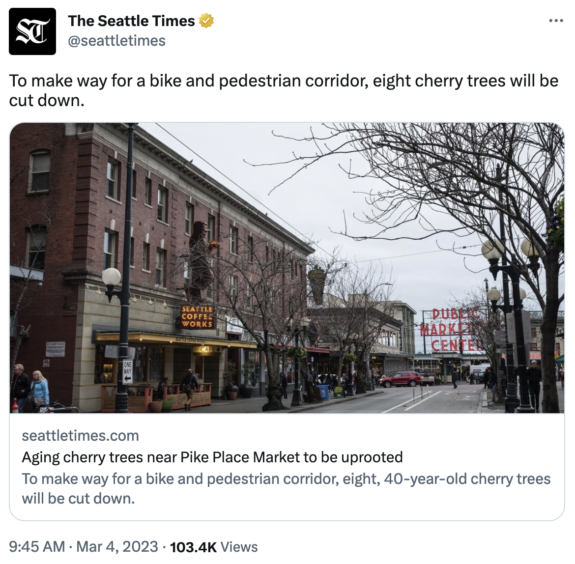 Contrary to what you may have read on Twitter or saw written on yellow signs on trees on Pike Street near the market, Seattle’s decision to cut down cherry trees on the block between 1st and 2nd Avenues has nothing to do with bike improvements.
Contrary to what you may have read on Twitter or saw written on yellow signs on trees on Pike Street near the market, Seattle’s decision to cut down cherry trees on the block between 1st and 2nd Avenues has nothing to do with bike improvements.
In fact, the project removing the trees will also remove the existing two-way bike lane on this block, a significant downgrade for biking. The change is part of the larger “Pike Pine Streetscape and Bicycle Improvements Project,” which does include exciting bike lane improvements between 2nd Ave and Bellevue Ave. However, the project’s design for the block with the doomed cherry trees will dramatically expand the amount of space for cars at the expense of all other users. Below are some concept images from the project’s outreach materials:
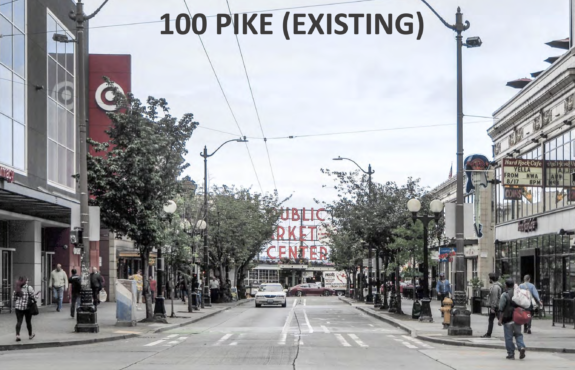
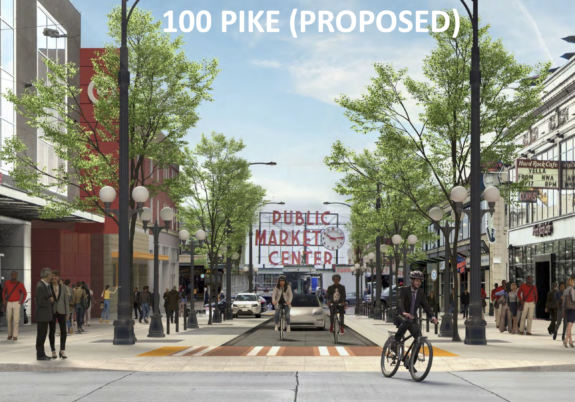 Looking at this, and you can see why it was so frustrating to read a Tweet from the Seattle Times that said, “To make way for a bike and pedestrian corridor, eight cherry trees will be cut down.” The exact opposite is true. This block’s design deletes the entire two-way bike lane and slightly reduces the sidewalk width in order to add car parking and widen the driving lane. Just because the concept image creators desaturated the colors in the “existing” photo doesn’t mean the “proposed” image is better. Here’s let’s try it another way:
Looking at this, and you can see why it was so frustrating to read a Tweet from the Seattle Times that said, “To make way for a bike and pedestrian corridor, eight cherry trees will be cut down.” The exact opposite is true. This block’s design deletes the entire two-way bike lane and slightly reduces the sidewalk width in order to add car parking and widen the driving lane. Just because the concept image creators desaturated the colors in the “existing” photo doesn’t mean the “proposed” image is better. Here’s let’s try it another way:
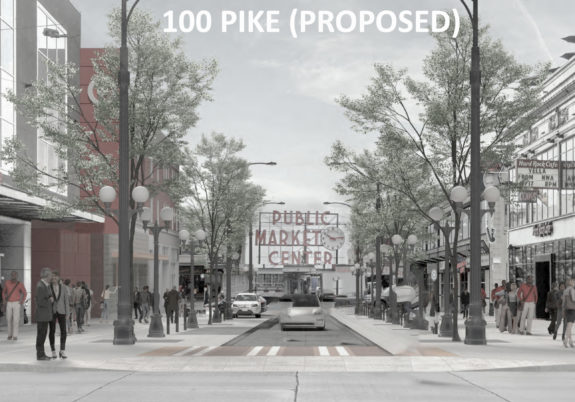
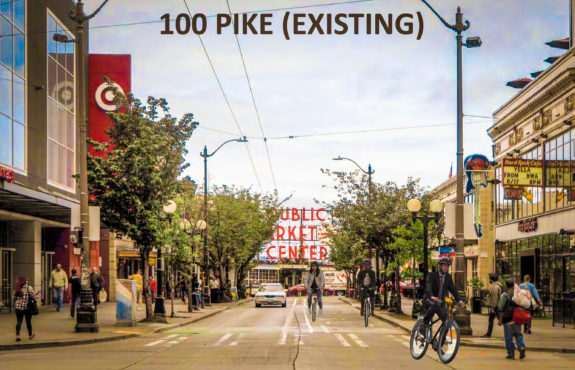 For what it’s worth, Seattle Bike Blog would happily see the city cancel this one block of the project and more forward with the rest. This “curbless” street concept has yet to actually prove to be an improvement for walking or biking in Seattle, though they keep trying it (Denny Way near Capitol Hill Station and Bell Street are two such examples). In our deeply-ingrained car culture, cars will occupy every inch they can. The wider the driving lane, the faster people will drive, and if there is space that is not physically blocked, people will park their car there or use it to pass someone else. A curbless street is only better for people walking and biking if there are significant obstacles for cars or if cars are not allowed at all. The proposed design is worse in every way.
For what it’s worth, Seattle Bike Blog would happily see the city cancel this one block of the project and more forward with the rest. This “curbless” street concept has yet to actually prove to be an improvement for walking or biking in Seattle, though they keep trying it (Denny Way near Capitol Hill Station and Bell Street are two such examples). In our deeply-ingrained car culture, cars will occupy every inch they can. The wider the driving lane, the faster people will drive, and if there is space that is not physically blocked, people will park their car there or use it to pass someone else. A curbless street is only better for people walking and biking if there are significant obstacles for cars or if cars are not allowed at all. The proposed design is worse in every way.
So keep the cherry trees until they actually need to be replaced. As David Kroman’s story in the Times notes (unlike the Tweet, the story gets the details right), cherry trees don’t love being in urban tree pits and might not last much longer. Maybe by then we’ll have a design for this block that truly does make it better for walking and biking.








Comments
6 responses to “No, the city is NOT cutting down cherry trees to build a bike project”
I mentioned this on Seattle Greenways, but I’ll copy here in case someone finds this interesting.
I think part of the problem is not so much mixing cars, bikes, peds but the fact that it still looks like a street. I suspect, that’s a physiological trigger for drivers to assume they have priority on the street.
Pike place, by comparison, is a unified mess. Every driver who enters that area is forced to go slowly and doesn’t have any clearly identified lane to drive in. It’s safe for everyone, unless someone with mental issues decides to do something rash. But that could happen anywhere.
What if SDOT changed the design to be more similar to Pike Place ? At least take out the lane delineation so that there is no clear boundary for peds and no clear pass-through for drivers. No pull-outs for passenger load, or truck loading. Everyone uniformly shares the space… and patiently.
The point is: if a street looks like it’s built for mixed use, drivers will immediately be aware – “where am I supposed to drive ? I don’t see any lanes” – and be more cautious.
The problem is that we have tried this and it doesn’t work. We have tried curbless streets on S Lander St outside Beacon Hill Station, E Denny Way outside of Capitol Hill Station, and most recently on Melrose Ave. What happens is cars will take up all space that they can access. There needs to be bollards, or ban cars completely.
I will need to look at these places in person. Satellite view isn’t clear enough.
In the mean time, let me ask: do you think Pike Place works ? If so, what is the difference.
The experience at Pike Place would be greatly enhanced without cars.
Pike Place can sometimes feel better due to the greater amount of people that walk there. If your argument is that a critical mass of people on foot result in cars driving slowly is something that ‘works’, I would say that if we ban cars from this street, it would work much better for everyone, including those in cars. I suspect most in cars are tourists that regret turning onto the street as soon as they see how many people are occupying it. Most would have a better experience being directed to a parking garage on Western Ave.
I completely agree that banning cars would be preferable. But that option isn’t on the table. So, I’m trying to understand why Pike Place is considered successful and how to ensure that Pike St would also be successful.
My guess is the lane markings must go. It must be a uniform appearing surface from building facade to building facade.
Maybe my experience is different, but I thought the one by the light rail station in Capitol Hill actually worked pretty well? I live pretty close, but I guess my perspective is completely skewed by the fact that I’m at the farmer’s market on that street every week, and it’s actually blocked off then, and tend to go in/out of the north exit otherwise. To me it always felt like cars avoided it for the most part, and those that don’t seem to acknowledge it as pedestrian prioritized.
Put it this way: if I imagine blithely walking into the street there as opposed to doing the same at the crossing Pike crossing in question today, sure feels like I’m a LOT more likely to die at pike :)
And of course, perceived safety and actual safety aren’t always well aligned.